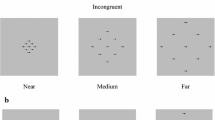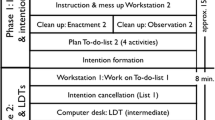Abstract
Recent prospective memory (PM) studies indicate that intentions are not always directly deactivated after completion, but that they entail aftereffects in terms of slower ongoing-task performance and/or commission errors on repeated (no-longer relevant) PM trials. In four experiments, we investigated whether aftereffects depend on the similarity between completed and currently performed PM-tasks. Aftereffects were reduced when PM-cues differed between the two PM-tasks (symbols vs. words) compared to when PM-cues belonged to the same category (symbols vs. symbols). This could be explained by the new dissimilar PM-task shifting spatial attention away from repeated PM-cues and, thus, attenuating processing of these cues. Moreover, a switch of the PM-response (to or within the manual modality) did not result in erroneous retrieval of the no-more-relevant PM-response (i.e., commission errors) but in erroneous retrieval of the currently relevant PM-response (i.e., false alarms). In addition, aftereffects vanished in conditions, in which participants did not perform a new PM-task. This finding indicates that forming a new PM-task set might be a prerequisite for aftereffects when the ongoing task changes between the two subsequent PM-tasks. Finally, we did not find evidence that forming a new, dissimilar PM-task representation led to overwriting of the completed intention representation, and thus to a change of the content or destabilization of its activation level.






Similar content being viewed by others
Notes
For exceptional cases of aftereffects in conditions of changing ongoing tasks, however exclusively in older but not younger adults, see Scullin et al. (2012, 2011).
Besides commission errors, we analyzed ongoing-task errors on PMREPEATED and oddball trials, which include misses (i.e., RTs > 3000 ms) as well as erroneous digit categorizations. Due to the complexity of the overall results and to allow readability, we refrained from including these errors in the manuscript. However, analyses of ongoing-task errors could be found in the online Supplemental Materials.
Note that we will refrain from the distinction between commission errorsPREVIOUS and commission errorsCURRENT in Experiments 3 and 4, because the designs do not allow to unambiguously separate between these error types.
Over the course of the repeated cycles of the experiment, participants might have noticed the appearance of PM-block targets in subsequent test blocks and thus adopted strategies in shielding PMREPEATED and oddball trials. This might have been especially true in the PM-cue-category-switch condition in which symbols could be ignored because they were completely irrelevant for the current PMWORD task. To disregard a strategic explanation due to repeated cycles we aimed at demonstrating that the difference between the PM-cue-category-similarity conditions is observable already in the first cycle (without repetition) and does not change over the course of the experiment. We compared RT and commission error aftereffects in the very first cycle between participants starting with the PM-cue-category repetition condition (n = 13, M = 178 ms, M = 11.5 %) and those starting with the PM-cue-category switch condition (n = 13, M = 81 ms, M = 0 %), which descriptively mirrored the overall analyses. Not surprisingly, and due to the immense loss in statistical power, the corresponding t tests on RTs, t(24) = 0.967, p = 0.343, d = 0.39, and commission errors, t(24) = 1.90, p = 0.074, d = 0.77, did not reach significance. In addition, analyses for the first session revealed that differences between aftereffects did not vary as a function of experiment half between conditions, both for RTs, F(1, 25) = 1.90, p = 0.180, nor commission errors, F(1, 25) = 2.56, p = 0.121. Similar analyses confirmed this pattern for the other experiments as well.
A further experiment (N = 25) conducted in our lab allowed to test for the modality dependence of this effect (Experiment 2B). Note that an erroneous activation of the current PM response was observed for response switches within different manual responses (Experiment 1) and for response switches from verbal to manual responses (Experiment 2). Experiment 2B included a switch from a manual to a verbal PM task. In this setting, the PMREPEATED trials did not erroneously trigger the currently relevant verbal PM response. We interpret this finding as increased control over response activation for verbal than manual responses. Therefore, before erroneous verbal responses could be executed, participants might have already performed the relatively fast manual ongoing-task response (see online Supplemental Materials for methods and results of Experiment 2B).
Note that whereas the terms focal/non-focal are typically used to refer to the processing requirements of PM cues relative to the ongoing task (i.e., focal = PM cue is automatically processed during the ongoing task; non-focal = PM cue identification requires additional processing), here the terms refer to the question whether performing the PM task in the test block automatically leads to processing (focal) of PMREPEATED and oddball trials or not (non-focal).
We have no explanation for the unexpectedly high oddball RT. As such deviations affect the size of the aftereffect, one might wonder whether oddballs as baseline are justified at all. Although we believe that oddballs represent the best possible baseline, we re-analyzed all modulations of aftereffects when taking standard trial RTs as baseline. In all experiments results remained identical and thus support our preferred interpretation of the data pattern of this study.
References
Anderson, F. T., & Einstein, G. O. (2016). The fate of completed intentions. Memory. doi:10.1080/09658211.2016.1187756.
Beck, S. M., Ruge, H., Walser, M., & Goschke, T. (2014). The functional neuroanatomy of spontaneous retrieval and strategic monitoring of delayed intentions. Neuropsychologia, 52, 37–50. doi:10.1016/j.neuropsychologia.2013.10.020.
Bugg, J. M., Scullin, M. K., & McDaniel, M. A. (2013). Strengthening encoding via implementation intention formation increases prospective memory commission errors. Psychonomic Bulletin and Review, 20(3), 522–527. doi:10.3758/s13423-013-0378-3.
Cohen, A.-L., Gordon, A., Jaudas, A., Hefer, C., & Dreisbach, G. (2016). Let it go: the flexible engagement and disengagement of monitoring processes in a non-focal prospective memory task. Psychological Research. doi:10.1007/s00426-016-0744-7.
Crovitz, H. F., & Daniel, W. F. (1984). Measurements of everyday memory: toward the prevention of forgetting. Bulletin of the Psychonomic Society, 22(5), 413–414.
Desimone, R., & Duncan, J. (1995). Neural mechanisms of selective visual attention. Annual Review of Neuroscience, 18(1), 193–222. doi:10.1146/annurev.ne.18.030195.001205.
Einstein, G. O., McDaniel, M. A., Thomas, R., Mayfield, S., Shank, H., Morrisette, N., & Breneiser, J. (2005). Multiple processes in prospective memory retrieval: Factors determining monitoring versus spontaneous retrieval. Journal of Experimental Psychology: General, 134(3), 327–342. doi:10.1037/0096-3445.134.3.327.
Gilbert, S. J., Hadjipavlou, N., & Raoelison, M. (2013). Automaticity and control in prospective memory: A computational model. PLoS One,. doi:10.1371/journal.pone.0059852.
Goschke, T., & Kuhl, J. (1993). Representation of intentions: Persisting activation in memory. Journal of Experimental Psychology. Learning, Memory, and Cognition, 19(5), 1211–1226. doi:10.1037/0278-7393.19.5.1211.
Kimmel, S. E., Chen, Z., Price, M., Parker, C. S., Metlay, J. P., Christie, J. D., & Gross, R. (2007). The influence of patient adherence on anticoagulation control with warfarin: results from the International Normalized Ratio Adherence and Genetics (IN-RANGE) Study. Archives of Internal Medicine, 167(3), 229–235. doi:10.1001/archinte.167.3.229.
Kliegel, M., Mackinlay, R., & Jäger, T. (2008). Complex prospective memory: Development across the lifespan and the role of task interruption. Developmental Psychology, 44(2), 612–617. doi:10.1037/0012-1649.44.2.612.
Kliegel, M., & Martin, M. (2003). Prospective memory research: Why is it relevant? International Journal of Psychology, 38(4), 193–194. doi:10.1080/00207590344000114.
Kliegel, M., Martin, M., McDaniel, M. A., & Einstein, G. O. (2001). Varying the importance of a prospective memory task: Differential effects across time- and event-based prospective memory. Memory, 9(1), 1–11. doi:10.1080/09658210042000003.
Landeira-Fernandez, J. (1996). Context and pavlovian conditioning. Brazilian Journal of Medical and Biological Research, 29(2), 149–173.
Marsh, R. L., Hicks, J. L., & Bink, M. L. (1998). Activation of completed, uncompleted, and partially completed intentions. Journal of Experimental Psychology: Learning, Memory, and Cognition, 24(2), 350–361. doi:10.1037/0278-7393.24.2.350.
McDaniel, M. A., & Einstein, G. O. (2000). Strategic and automatic processes in prospective memory retrieval: A multiprocess framework. Applied Cognitive Psychology, 14(7), S127–S144. doi:10.1002/acp.775.
McDaniel, M. A., Robinson-Riegler, B., & Einstein, G. O. (1998). Prospective remembering: Perceptually driven or conceptually driven processes? Memory and Cognition, 26(1), 121–134. doi:10.3758/BF03211375.
Penningroth, S. L. (2011). When does the intention-superiority effect occur? Activation patterns before and after task completion, and moderating variables. Journal of Cognitive Psychology, 23(1), 140–156. doi:10.1080/20445911.2011.474195.
Pink, J. E., & Dodson, C. S. (2013). Negative prospective memory: Remembering not to perform an action. Psychonomic Bulletin and Review, 20(1), 184–190. doi:10.3758/s13423-012-0337-4.
Scullin, M. K., & Bugg, J. M. (2013). Failing to forget: Prospective memory commission errors can result from spontaneous retrieval and impaired executive control. Journal of Experimental Psychology: Learning, Memory, and Cognition, 39(3), 965–971. doi:10.1037/a0029198.
Scullin, M. K., Bugg, J. M., & McDaniel, M. A. (2012). Whoops, I did it again: Commission errors in prospective memory. Psychology and Aging, 27(1), 46–53. doi:10.1037/a0026112.
Scullin, M. K., Bugg, J. M., McDaniel, M. A., & Einstein, G. O. (2011). Prospective memory and aging: Preserved spontaneous retrieval, but impaired deactivation, in older adults. Memory and Cognition, 39(7), 1232–1240. doi:10.3758/s13421-011-0106-z.
Scullin, M. K., Einstein, G. O., & McDaniel, M. A. (2009). Evidence for spontaneous retrieval of suspended but not finished prospective memories. Memory and Cognition, 37(4), 425–433. doi:10.3758/MC.37.4.425.
Smith, R. E. (2003). The cost of remembering to remember in event-based prospective memory: Investigating the capacity demands of delayed intention performance. Journal of Experimental Psychology. Learning, Memory, and Cognition, 29(3), 347–361. doi:10.1037/0278-7393.29.3.347.
Smith, R. E., Hunt, R. R., McVay, J. C., & McConnell, M. D. (2007). The cost of event-based prospective memory: Salient target events. Journal of Experimental Psychology: Learning, Memory, and Cognition, 33(4), 734–746. doi:10.1037/0278-7393.33.4.734.
Terry, W. S. (1988). Everyday forgetting: Data from a diary study. Psychological Reports, 62(1), 299–303. doi:10.2466/pr0.1988.62.1.299.
Walser, M., Fischer, R., & Goschke, T. (2012). The failure of deactivating intentions: Aftereffects of completed intentions in the repeated prospective memory cue paradigm. Journal of Experimental Psychology: Learning, Memory, and Cognition, 38(4), 1030–1044. doi:10.1037/a0027000.
Walser, M., Fischer, R., Goschke, T., Kirschbaum, C., & Plessow, F. (2013). Intention retrieval and deactivation following an acute psychosocial stressor. PLoS One 8(12), e85685. doi:10.1371/journal.pone.0085685.
Walser, M., Goschke, T., & Fischer, R. (2014a). The difficulty of letting go: moderators of the deactivation of completed intentions. Psychological Research, 78(4), 574–583. doi:10.1007/s00426-013-0509-5.
Walser, M., Plessow, F., Goschke, T., & Fischer, R. (2014b). The role of temporal delay and repeated prospective memory cue exposure on the deactivation of completed intentions. Psychological Research, 78(4), 584–596. doi:10.1007/s00426-013-0510-z.
Waszak, F., Hommel, B., & Allport, A. (2003). Task-switching and long-term priming: Role of episodic stimulus—task bindings in task-shift costs. Cognitive Psychology, 46(4), 361–413. doi:10.1016/S0010-0285(02)00520-0.
Acknowledgments
The authors are grateful to Maximilian Böhland, Christian Grabautzki, Julia Kleindienst, Nicole Rothe, and Heike Stein for assistance in data collection.
Author information
Authors and Affiliations
Corresponding author
Ethics declarations
Funding
This study was partly supported by the German Research Foundation (DFG grant SFB 940).
Conflict of interest
All authors declare that they have no conflict of interest.
Ethical approval
All procedures performed in studies involving human participants were in accordance with the ethical standards of the institutional and/or national research committee and with the 1964 Helsinki declaration and its later amendments or comparable ethical standards.
Informed consent
Informed consent was obtained from all individual participants included in the study.
Electronic supplementary material
Below is the link to the electronic supplementary material.
Rights and permissions
About this article
Cite this article
Walser, M., Goschke, T., Möschl, M. et al. Intention deactivation: effects of prospective memory task similarity on aftereffects of completed intentions. Psychological Research 81, 961–981 (2017). https://doi.org/10.1007/s00426-016-0795-9
Received:
Accepted:
Published:
Issue Date:
DOI: https://doi.org/10.1007/s00426-016-0795-9




